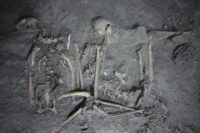 The remains of a spider monkey have been discovered in the pre-Hispanic central ceremonial complex of Teotihuacan, Mexico. Spider monkeys were exotic animals not native to the arid highlands of Central Mexico, and this one was likely a diplomatic gift from Teotihuacan’s Maya neighbors. Radiocarbon dated to the second half of the 3rd century A.D., the spider monkey is the earliest example of a primate in captivity in the Americas, and the first evidence of gift diplomacy between Teotihuacan and the Maya city-states in the Early Classic period (250-550 A.D.).
The remains of a spider monkey have been discovered in the pre-Hispanic central ceremonial complex of Teotihuacan, Mexico. Spider monkeys were exotic animals not native to the arid highlands of Central Mexico, and this one was likely a diplomatic gift from Teotihuacan’s Maya neighbors. Radiocarbon dated to the second half of the 3rd century A.D., the spider monkey is the earliest example of a primate in captivity in the Americas, and the first evidence of gift diplomacy between Teotihuacan and the Maya city-states in the Early Classic period (250-550 A.D.).
Located about 25 miles northeast of what is now Mexico City, Teotihuacan was a religious, cultural and commercial center in the Mexican Highlands from the 1st century until its collapse around 500 A.D. At its peak in 450 A.D., it was the largest and most populous city in the ancient Americas with a conservative population estimate of 150,000. Half of the people in the Valley of Mexico lived in Teotihuacan.
It was not ruled by dynastic kings like the Maya polities. We don’t really know what form of government ran Teotihuacan, but we know it had powerful warlords because in the late 4th century, one of them conquered the Maya power center of Tikal 600 miles away. Maya inscriptions record Teotihuacan contact with the Mayan world reached as far as Honduras, perhaps even conquering city-states there, and certainly spreading its cultural presence, notably its characteristic obsidian crafts and architectural styles.
The complete skeleton of the spider monkey was unearthed at the Plaza of Columns Complex of Teotihuacan. It is a sacrificial offering deposited at the temple with its hands tied behind its back and feet tethered together. This type of binding was common among human and animal sacrifice victims buried alive. Next to it were found the complete skeletal remains of a golden eagle, the skull of a puma, several rattlesnakes and ritual objects (greenstone figurines, shell artifacts, obsidian blades). The monkey was female and between five and eight years old at the time of death. Analysis of the remains found that it was captured before the age of three and lived in captivity for more than two years after that. It ate a diet of maize, arrowroot and chili pepper, all of which had to have been prepared for it by humans. Before its arrival in Teotihuacan, it lived in a humid environment and ate plants and roots.
This finding allows researchers to piece evidence of high diplomacy interactions and debunks previous beliefs that Maya presence in Teotihuacán was restricted to migrant communities, said [anthropological archaeologist Nawa] Sugiyama, who led the research.
“Teotihuacán attracted people from all over, it was a place where people came to exchange goods, property, and ideas. It was a place of innovation,” said Sugiyama, who is collaborating with other researchers, including Professor Saburo Sugiyama, co-director of the project and a professor at Arizona State University, and Courtney A. Hofman, a molecular anthropologist with the University of Oklahoma. “Finding the spider monkey has allowed us to discover reassigned connections between Teotihuacán and Maya leaders. The spider monkey brought to life this dynamic space, depicted in the mural art. It’s exciting to reconstruct this live history.”
The find has been published in the journal Proceedings of the National Academy of Sciences and can be read in its entirety here.